"Foreign Insulators" - Hodge Podge Month
by Marilyn Albers
Reprinted from "INSULATORS - Crown Jewels of the Wire", August 1982, page 4
New Find from
Esperanza Glass Factory, Segovia, Spain:
The insulator pictured here is a two piece
cemented emerald green glass beauty, which now has the new CD# 350. It is
faintly embossed ESPERANZA S.A. on the edge of the crown just above the wire
groove. It measures 5-1/4" across the widest part of the skirt and stands
6" tall. This insulator, according to Mel Harder (Virginia Beach,
Virginia), may be one of the only two known to be still in existence. He says,
"In all my travels I only saw or found the two we got from a fallen down
abandoned (power) line way back in the mountains near Granada. I showed it to a
gent who works for E.S.A., and he could not find that style among the factory
records. However, he said that they did not keep very good files prior to the
Civil War, and as a glass maker he felt it predated that era. He also said it
was not uncommon for large companies to subcontract some work to small local
glass works, and that may have been where it was produced. My Son and I walked
and carefully searched several miles of the line from one village to another and
never saw a hint of these except the two we found. In fact, after three years of
tramping the Spanish countryside, we never did see any more like it."
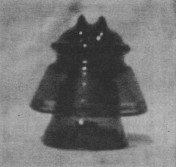
Mel
was generous enough to let me buy the one you see in the picture above, and I
certainly feel honored to have it in my collection. If any of you collectors out
there have found any others in this style, please let me know "just for the
record". CD# 350 will be included in a future supplement to the book Glass
Insulators from Outside North America, which was published less than a year ago.
A few days before writing this month's column, I also acquired from Mel two
embossing variations of CD# 380. This is also a cemented two piece insulator in
green glass, though a different style and quite a bit smaller than CD# 350.
Heretofore the only CD 380 we had listed was embossed Folembray/No 2205
(France), but the two new variations are (1) E.S.A./212 (Spain) and (2)
L'ELECTRO VERRE/205 (manufactured in France, but found in Spain). (Drawing next
page.)
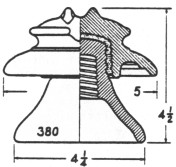
Sketch #1-A
Two Unique White Porcelain Insulators Found in The
Netherlands:
These
porcelains belong to Laura Van der Endt, who now lives in Sidney, Australia, but
who was born and grew up in Holland. On a visit home a few years back, after
she'd become an insulator collector, she was able to find these two to add to
her collection.
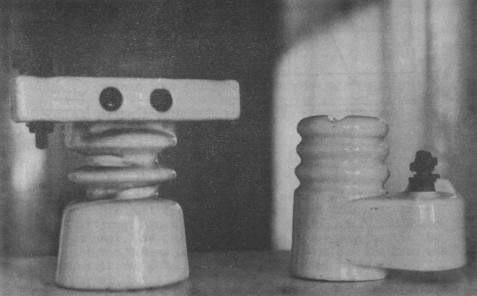
Laura learned how to take the necessary measurements, and made
shadow drawings of the two insulators. She brought these drawings along with her
on a visit to the United States last spring. She convinced her three traveling
companions to include Phoenix, Arizona, on their agenda, and Laura was able to
spend some time visiting with Jack Tod. From her shadow profiles and
measurements Jack made the perfect scale drawings you see on the following page.
He also made drawings of several other porcelain insulators that Laura brought
from Australia. The four travelers saw many points of interest during their
month long journey across the U.S. and visited with many other collectors.
Fortunately for me, Houston was one of their planned stops. My Australian glass
and porcelain collection was considerably larger after Laura's visit! But now
back to the picture:
U-2063, to the left, is a power insulator. The
"crossbar", a separate piece, is also porcelain, and is connected with
little bolts to the main part of the insulator. On each end of the crossbar is a
brass clamp to hold the wire. We're not sure how this particular style insulator
was used, but apparently it was designed to hold two wires at the same time. The
trademark of the Turku Pottery (located in Turku, Finland) appears as an incuse
marking in two places on the insulator: on the crossbar at the center, and on
the skirt. This is pretty substantial proof that Turku insulators were exported
to at least one other country.
The other insulator in the picture, to the right,
is a fuse cut out pintype. It has been assigned the number U-1953. The letters
AKA appear as an incuse marking on the crown, and a simple A can be found on the
skirt, as indicated by the arrows. These markings are so far unattributed as to
manufacturer.
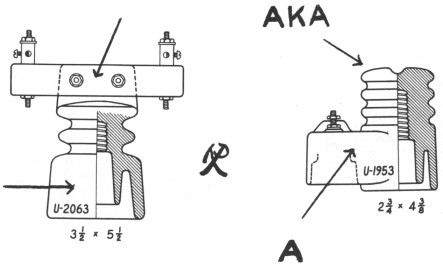
An Alien Appears:
This picture belongs to Dave Potts of Woodland,
California. It was taken of a telephone pole in Arbuckle, California. The
insulator on the right is a Hemingray 16 - CD# 121. Perfectly normal! The
insulator on the left is a clear CD# 422 (or as some of you still persist in
calling it - CD# 124.6). Now how do you suppose this little jewel from Australia
found its way to this particular perch?
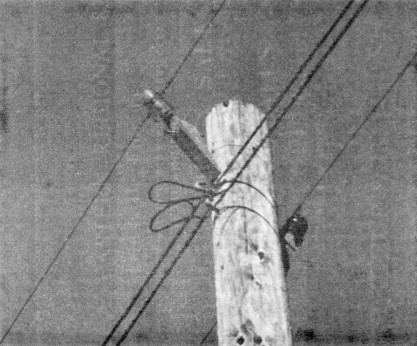
It could be either an AGEE (Australian
glass manufacturers) or a C.C.G. (Crown Crystal Glass). If that is a standard
U.S. wooden pin that holds it, it can't fit those smaller Australian threads
very well! I would imagine the threads on the pin are pretty well creamed!
An
Old Telegraph Insulator from Tunisia:
My friend George Cowan (Houston, Texas)
knows he's not to return from his work assignments overseas without an
insulator! His last trip was to Africa, and he brought me a very
"different" sort of insulator. George works for Amaco International,
and several months ago he was way out in the middle of the Sahara Desert on a
drilling rig. The crew was located near the town of Kebili, which used to be an
old slave market, but is now an Army base. Running between Kebili and the next
town of Douz (also an Army base) is a line of old telegraph poles with two
insulators on each crossarm. The wires are all down! George somehow managed to
retrieve one of the insulators for me. It's unlike any I've ever seen before.
The outer shell is of heavy cast iron with a seam running up the sides and
across the top of the crown. It has an inner skirt of white porcelain, as you
can see in the picture to the right. The small pinhole is still partially filled
with cement, but George tells me the insulator wriggled right off the metal pin.
I cannot tell until the cement is removed, but I am assuming the threads are
small, too. George is a history buff, and he brought me up to date on the fact
that Tunisia was a French colony until the mid 1950's. So these insulators are
probably of French origin, although it would not be entirely impossible that
they were made in Tunisia. The insulator is unmarked, is 3-1/8" wide at the
base, and stands 4-1/4" high. It is extremely heavy for its size, and
certainly does have the look of a little French gingerbread man!
| 